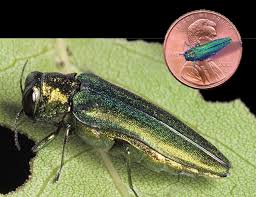
By Elle O’Casey, VT Agency of Natural Resources and Scott Waterman, VT Agency of Agriculture, Food & Markets
The Emerald Ash Borer, or EAB, is an invasive insect from Asia, infecting and destroying ash trees that it inhabits. It was first discovered in Vermont in February of 2018, including parts of Bennington, Caledonia, Chittenden, Franklin, Grand Isle, Orange, Washington, and Windham Counties. Officials from the State of Vermont are reminding Vermonters in EAB infested areas that the beetles are emerging from affected trees. Moving any infested material, especially ash firewood, logs, and pruning debris, can quickly spread the destructive insect. Optimal practices are to move ash from the infested area only during the “non-flight season” before EAB emerges. This, and other recommendations to slow the spread of EAB, are described at vtinvasives.org/eab.
These “slow-the-spread” recommendations have been modified for 2019, extending the “non-flight season” until June 1st to better reflect local conditions and insect biology. After careful consideration of EAB biology and Vermont weather records, the Department of Forests, Parks and Recreation and the Agency of Agriculture, Food and Markets have determined that EAB beetle emergence does not begin until June in Vermont.
EAB larvae kill ash trees by tunneling under the bark and interrupting the vascular system. Ash trees comprise approximately 5% of Vermont forests and are also a very common and important urban tree. Resources to help communities, landowners, and others plan for the impacts of EAB and the loss of ash trees, while maintaining healthy forests and public safety, are available at vtinvasives.org/eab.
Vermonters are urged to look for signs and symptoms of the insect on ash trees and report suspicious findings on vtinvasives.org. Detailed information about how to identify ash trees, how to look for EAB, and resources to promote community awareness of EAB are also available. All these resources can be found at www.vtinvasives.org/eab.

